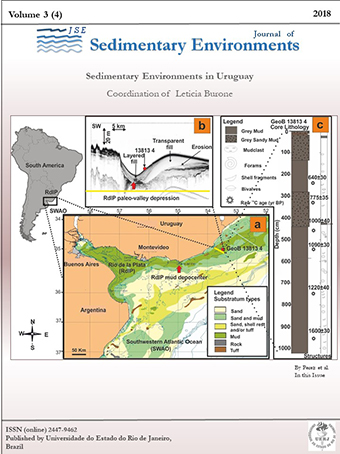GEOMORPHOLOGICAL AND SEDIMENTOLOGICAL CHARACTERIZATION OF THE URUGUAYAN CONTINENTAL MARGIN: A REVIEW AND STATE OF ART / CARACTERIZAÇÃO GEOMORFOLÓGICA E SEDIMENTOLÓGICA DA MARGEM CONTINENTAL DO URUGUAI: UMA REVISÃO E ESTADO DA ARTE
DOI:
https://doi.org/10.12957/jse.2018.39150Keywords:
Sedimentology. Geomorphology. Surface sedimentation. Hydrology. Southwestern Atlantic. / Palavras-chave, Sedimentologia. Geomorfologia. Sedimentação superficial. Hidrologia. Atlântico Sudoeste.Abstract
The Uruguayan Continental Margin is located in a strategic location of great relevance to understand the dynamics of the regional and global climate and to study the sedimentary processes. The Río de la Plata represents the largest fluvial discharge of the Southwest Atlantic (23.000 m3/s of water and 57.000.000 m3/year of sediment for the South Atlantic Ocean). The sub-surface and deep circulation are characterized by the confluence of water masses with contrasting thermohaline characteristics that determine the formation of well-marked hydrological fronts. In the continental shelf, this characteristic is represented by the Subtropical Shelf Front, as a shallow extension of the Brazil-Malvinas Confluence that occurs in deep water off the shelf. Although the knowledge of the regional circulation is acceptable, there are significant gaps in the knowledge related to the influence of this complex hydrological system on sedimentation processes. The objective of this work is to synthesize the present knowledge about the morpho-sedimentary characteristics of the Uruguayan Continental Margin and the processes involved in its formation. It also aims to discuss some knowledge gaps that are the subject of current research in the region. The knowledge reflects the scientific-technological evolution at a global level that is translated in the increase of recent works on the continental slope. Nowadays, most of the available information is associated with the inner shelf and upper slope. Starting from the basis of the close relationship between bathymetry and sedimentological distribution it is clear that efforts should be concentrated on the better understanding of the interaction between the shelf and the slope. The scientific knowledge regarding sedimentology and geochemistry along the Uruguayan Continental Margin is still, scarce and heterogeneous. However, it indicates complexity in the sedimentary coverture present both in the continental shelf and slope. The Uruguayan Continental Margin can be considered as an in situ laboratory to improve the understanding of the influence of oceanic hydrodynamics on the margin configuration, a key point to achieve better paleoceanographic interpretations. In this sense, due to the complexity of both modern hydrology and morphological configuration of the margin, it would be interesting to understand the relative importance of the control of each environment on surface sedimentation. A better understanding of the processes that link the near bottom circulation and continental slope features is needed. At the same time, this will allow deepening a new field of research in Uruguay, considering the joint and interrelated vision between sedimentary and oceanographic processes.
Resumo
A Margem Continental do Uruguai está localizada num local estratégico de grande relevância para entender a dinâmica do clima regional e global e para estudar os processos sedimentares. O Río de la Plata representa a maior descarga fluvial do Atlântico Sudoeste (23.000 m3/s de água e 57.000.000 m3/ano de sedimento para o Oceano Atlântico Sul). A circulação de subsuperfície e profunda são caracterizadas pela confluência de massas de água com características termohalinas contrastantes que determinam a formação de frentes hidrográficas bem marcadas. Na plataforma continental, essa característica é representada pela Frente Subtropical da Plataforma, uma extensão rasa da Confluência Brasil-Malvinas que ocorre em águas profundas ao largo da plataforma. Embora seja considerável o conhecimento da circulação regional, existem lacunas significativas no conhecimento da influência deste complexo sistema hidrológico nos processos de sedimentação. O objetivo deste trabalho é sintetizar o conhecimento atual sobre as características morfo-sedimentares da Margem Continental Uruguaia e os processos envolvidos na sua formação. Também pretende discutir algumas lacunas de conhecimento que são objeto de pesquisas atuais na região. O conhecimento reflete a evolução científico-tecnológica a nível global, que se traduz no aumento de trabalhos recentes na vertente continental. Atualmente, a maior parte da informação disponível está associada à plataforma continental interna e ao talude continental superior. Partindo da base da estreita relação entre a batimetria e a distribuição sedimentológica, torna-se claro que os esforços devem ser concentrados na melhor compreensão da interação entre a plataforma e o talude continental. O conhecimento científico sobre sedimentologia e geoquímica ao longo da Margem Continental do Uruguai é ainda escasso e heterogêneo. No entanto, os dados existentes indicam que a cobertura sedimentar presente tanto na plataforma quanto no talude continental é complexa. A Margem Continental do Uruguai pode ser considerada um laboratório in situ para melhorar a compreensão da influência da hidrodinâmica oceânica na configuração da margem, ponto chave para se obterem melhores interpretações paleoceanográficas. Nesse sentido, devido à complexidade da hidrologia moderna e da configuração morfológica da margem, seria interessante entender a importância relativa do controle de cada ambiente sobre a sedimentação superficial. É necessário um melhor entendimento dos processos que ligam as características de circulação próxima do continente à que ocorre no talude continental. Este conhecimento permitirá aprofundar um novo campo de pesquisa no Uruguai, considerando a visão conjunta e inter-relacionada entre processos sedimentares e oceanográficos.
Downloads
Published
Issue
Section
License

Journal of Sedimentary Environments (JSE) is licensed under a Creative Commons Attribution-Noncommercial-Share Alike 4.0 International License.

